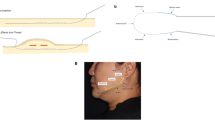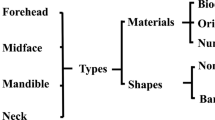Abstract
Background
Polydioxanone (PDO) is absorbable thread which is usually used for wound closure and face lifting. These days, PDO thread is used increasingly for aesthetic purposes such as correction of facial wrinkles, laxity and even rhinoplasty in many oriental traditional medicine clinics. As rhinoplasty with PDO thread increases, complications also increase. In this study, we will report on the clinical features of patients who got rhinoplasty using PDO thread.
Methods
From August 2018 to July 2019, seven patients (three males and four females) visited our clinic for complications after rhinoplasty with PDO thread. We checked ultrasonography and laboratory findings including wound cultures. We used conservative treatment using antibiotics and performed surgery on three patients.
Results
Three patients experienced severe complications with open wounds, abscesses and skin necrosis. Four patients experienced mild complications including redness and thread exposure without open wounds. The location of infection included the nasal tip and inner lining. Six patients had a history of rhinoplasty before. On ultrasonography, abscess formation was seen around the implant inserted before. During the operation, PDO thread cannot be seen except in one patient.
Conclusions
PDO thread cannot be seen in radiologic findings and can cause severe infections like abscess formation with open wounds. In severe infections, massive debridement with the removal of the implant would be required. PDO thread is absorbed usually after six months; mild infection can be controlled by the conservative treatment. The best is not undergoing rhinoplasty with PDO thread for patients who had implants because of potential side effects.
Level of Evidence IV
This journal requires that authors assign a level of evidence to each article. For a full description of these Evidence-Based Medicine ratings, please refer to the Table of Contents or the online Instructions to Authors www.springer.com/00266.





Similar content being viewed by others
References
Lerwick E (1983) Studies on the efficacy and safety of polydioxanone monofilament absorbable suture. Surg Gynecol Obstet 156:51–55
Yun YH, Kim TY, Lim TJ, Hwang YH, Choi IH (2015) Narrative review and propose of thread embedding acupuncture procedure for facial wrinkles and facial laxity. J Korean Med Ophthalmol Otolaryngol Dermatol 28:119–133
Medical service act. Statutes of the Republic of Korea. No. 16555. 27 August 2019. Print
Cho SP (2013) Guideline for aesthetic procedures using maesun. Shinheung Med Science, Seoul
Yoon JH, Kim SS, Oh SM, Kim BC, Jung W (2018) Tissue changes over time after polydioxanone thread insertion: an animal study with pigs. J Cosmet Dermatol 18:885–891
Kim CM, Kim BY, Dong HS, Lee SJ, Moon HR, Ryu HJ (2019) The efficacy of powdered polydioxanone in terms of collagen production compared with poly-L-lactic acid in a murine model. J Cosmet Dermatol 00:1–6
Molea G, Schonauer F, Bifulco G, D'Angelo D (2000) Comparative study on biocompatibility and absorption times of three absorbable monofilament suture materials (Polydioxanone, Poliglecaprone 25, Glycomer 631). Br J Plast Surg 53:137–141
Bertossi D, Botti G, Gualdi A, Fundaro P, Nocini R, Pirayesh A, Van der Lei B (2019) Effectiveness, longevity, and complications of facelift by barbed suture insertion. Aesthet Surg J 39:241–247
Lee HJ, Yoon KC, Lee MJ (2018) Outcome of facial rejuvenation with polydioxanone thread for Asians. J Cosmet Laser Ther 20:189–192
Lee HY, Yang HJ (2018) Rhinoplasty with barbed threads. Plast Reconstr Surg Glob Open. https://doi.org/10.1097/GOX.00000000000019676
Yang HJ, Lee HY (2011) Successful use of squeezed-fat grafts to correct a breast a affected by poland syndrome. Aesthetic Plast Surg 35:418–425
Choi JS, Yang HJ, Kim BS, Kim JD, Kim JY, Yoo BY, Park KN, Lee HY, Cho YW (2009) Human extracellular matrix (ECM) powders for injectable cell delivery and adipose tissue engineering. J Control Release 139:2–7
Choi JS, Kim BS, Kim JD, Choi YC, Lee EK, Park KN, Lee HY, Cho YW (2011) In vitro expansion of human adipose-derived stem cells in a spinner culture system using human extracellular matrix powders. Cell Tissue Res 345:415–423
Kim JH, Park SH, Lee BH, Jeong HS, Yang HJ, Suh IS (2016) Early intervention with highly condensed adipose-derived stem cells for complicated wounds following filler injections. Aesthetic Plast Surg 40:428–434
Jung GS (2019) Minimally invasive rhinoplasty technique using a hyaluronic acid filler and polydioxanone threads: an effective combination. Facial Plast Surg 35:109–110
Helmy Y (2018) Non-surgical rhinoplasty using filler, botox, and thread remodeling: retro analysis of 332 cases. J Cosmet Laser Ther 20:293–300
Kuduban O, Kuduban SD (2015) Early skin reaction of polydioxanone suture material following septorhinoplasty. Am J Case Rep 16:276–278
Shin JJ, Park JH, Lee JM, Ryu HJ (2016) Mycobacterium massiliense infection after thread-lift insertion. Dermatol Surg 10:1219–1222
Kasai H, Yashiro K, Kawahara Y (2018) Multiple ulcers on the face due to infection after thread-lifting. J Dermatol. https://doi.org/10.1111/1346-8138.14483
Lee JW, Kim YJ, Kim H, Nam SH, Shin BM, Choi YW (2013) Nasal carriage of 200 patients with nasal bone fracture in Korea. Arch Plast Surg 40:536–541
Jameson J, Fauci AS, Kasper DL, Hauser SL, Longo DL, Loscalzo J (2018) Staphylococcal Infections. In: Lowy FD (ed) Harrison's principles of internal medicine 20e. McGraw-Hill, New York
Saravolatz LD, Stein GE (2019) Delafloxacin: a new anti-methicillin-resistant staphylococcus aureus fluoroquinolone. Clin Infect Dis 68:1058–1062
Lemaire S, Kosowska-Shick K, Appelbaum PC, Glupczynski Y, Bambeke F, Tulkens PM (2011) Activity of moxifloxacin against intracellular community-acquired methicillin-resistant Staphylococcus aureus: comparison with clindamycin, linezolid and co-trimoxazole and attempt at defining an intracellular susceptibility breakpoint. J Antimicrob Chemother 66:596–607
Lamb RC, Dawn G (2014) Cutaneous non-tuberculous mycobacterial infections. Int J Dermatol 53:1197–1204
Zimmerli W, Lew PD, Waldvogel FA (1984) Pathogenesis of foreign body infection. Evidence for a local granulocyte defect. J Clin Invest 73:1191–1200
Author information
Authors and Affiliations
Corresponding author
Ethics declarations
Conflicts of interest
The authors declare that they have no conflict of interest.
Ethical Approval
This study was a retrospective case series. The study protocol was approved by the institutional review board (IRB, number: 2019-04-018). All procedures in the study involving human participants were performed in accordance with the ethical standards of the institutional and/or national research committee and with the 1964 Declaration of Helsinki and its later amendments or comparable ethical standards.
Informed Consent
For this type of study, informed consent is not required.
Additional information
Publisher's Note
Springer Nature remains neutral with regard to jurisdictional claims in published maps and institutional affiliations.
Rights and permissions
About this article
Cite this article
Kim, H.J., Lee, S.J., Lee, J.H. et al. Clinical Features of Skin Infection After Rhinoplasty with Only Absorbable Thread (Polydioxanone) in Oriental Traditional Medicine: A Case Series Study. Aesth Plast Surg 44, 139–147 (2020). https://doi.org/10.1007/s00266-019-01550-y
Received:
Accepted:
Published:
Issue Date:
DOI: https://doi.org/10.1007/s00266-019-01550-y




